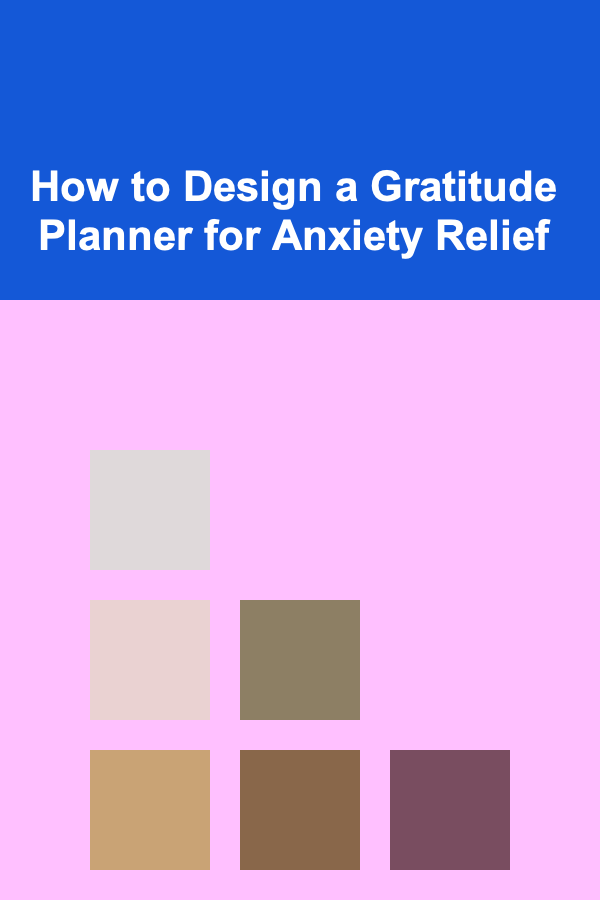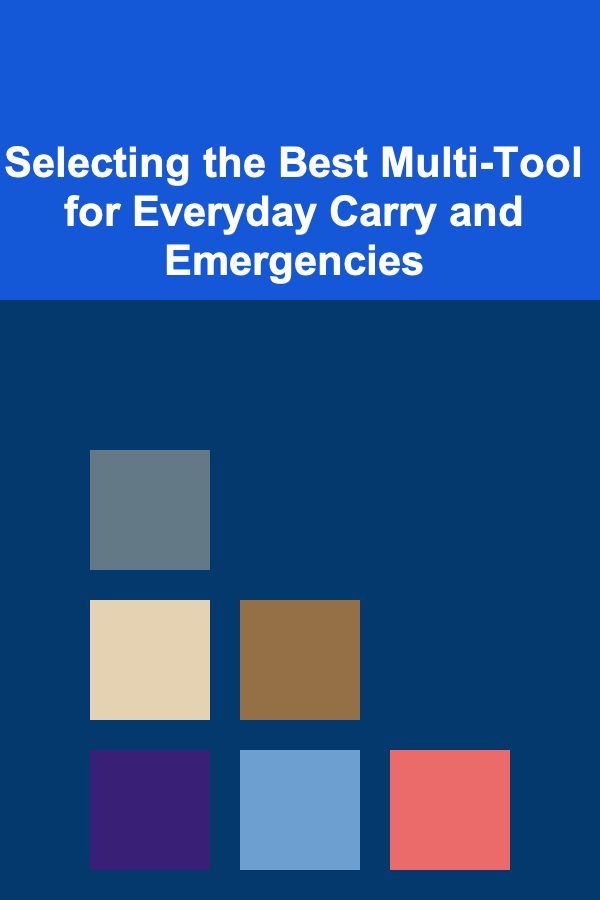
How to Design a Gratitude Planner for Anxiety Relief
ebook include PDF & Audio bundle (Micro Guide)
$12.99$8.99
Limited Time Offer! Order within the next:

Anxiety is a prevalent issue in today's fast-paced world, and finding ways to manage it is crucial for overall well-being. Among the many methods available to alleviate anxiety, practicing gratitude has been proven to have a significant positive impact on mental health. One effective way to incorporate gratitude into daily life is by designing a gratitude planner that can be used to shift focus from stressors to the positive aspects of life. This article will explore how you can create a personalized gratitude planner to reduce anxiety, enhance emotional well-being, and cultivate mindfulness.
Why Gratitude Can Help Alleviate Anxiety
Before diving into the specifics of how to design a gratitude planner, it's important to understand why practicing gratitude is so beneficial for anxiety relief. Gratitude is the act of recognizing and appreciating the positive elements in one's life, no matter how big or small. Research in the field of positive psychology shows that gratitude can lead to improved mood, reduced stress, and even better physical health. Here's why gratitude is particularly effective for anxiety relief:
1. Shifts Focus Away from Stressors
Anxiety often arises from an overactive mind, constantly focusing on worst-case scenarios, uncertainties, or negative thoughts. Gratitude, on the other hand, requires you to intentionally focus on the present moment and the good things in your life. This shift in focus can reduce the mental clutter that fuels anxiety.
2. Promotes Positive Emotions
When you express gratitude, your brain releases dopamine and serotonin---neurotransmitters associated with happiness and well-being. These chemicals can act as natural mood elevators, counteracting the feelings of dread and unease that come with anxiety.
3. Helps Reframe Negative Thoughts
For individuals with anxiety, negative thought patterns are common. Gratitude practices help reframe these thoughts by providing a new perspective. Instead of focusing on what's wrong, you start noticing what's going well, which can create a more balanced outlook on life.
4. Encourages Mindfulness
Gratitude fosters mindfulness by encouraging you to be present in the moment and recognize the good things around you. Mindfulness has been shown to reduce anxiety by helping individuals stay grounded and less caught up in their thoughts.
5. Reduces Rumination
People with anxiety often engage in rumination---repeatedly thinking about past events or worries about the future. Gratitude practice encourages living in the present moment, effectively breaking the cycle of rumination.
The Concept of a Gratitude Planner
A gratitude planner is a tool designed to help individuals regularly record things they are grateful for. It serves as a daily ritual that fosters mindfulness, emotional awareness, and a positive mindset. Unlike a typical journal, which may focus on broad reflections or deep introspection, a gratitude planner specifically targets positive emotions and helps users cultivate a habit of appreciation.
A well-designed gratitude planner can help you acknowledge your blessings, express thankfulness, and build a daily practice of gratitude. The goal is not just to feel grateful but to shift your mindset over time, ultimately alleviating feelings of anxiety.
Key Features of a Gratitude Planner
A gratitude planner should have several essential features to make it effective. These features ensure that the planner is comprehensive, easy to use, and adaptable to your unique needs.
1. Daily Gratitude Entries
The core of a gratitude planner is the daily section where you record the things you are grateful for. This could be as simple as a positive event, a kind gesture from someone, or even something about yourself that you appreciate. Writing daily entries helps reinforce the habit of gratitude.
- What to Include: Each day, write down at least three things you are grateful for. These can be specific to that day or recurring elements of your life that consistently bring you joy.
2. Mood Tracker
A mood tracker can be added to the planner to help you observe how gratitude affects your emotional state over time. You can rate your mood at the start and end of the day, noting any changes. By looking at the correlation between your gratitude practice and mood, you can gain deeper insight into the effects of gratitude on your anxiety.
- How to Use It: Rate your mood on a scale of 1 to 10, with 1 being very anxious and 10 being very calm. Over time, look for patterns---do you tend to feel calmer on days when you express gratitude?
3. Affirmations Section
Affirmations are positive statements that help reinforce the mindset you want to cultivate. Including affirmations in your gratitude planner can give you the mental tools to challenge negative thinking patterns and replace them with constructive beliefs.
- How to Use It: Write an affirmation every morning that resonates with you. It could be as simple as "I am grateful for today" or "I have the strength to manage my anxiety."
4. Reflection Prompts
Reflection prompts are questions or statements designed to inspire deeper thinking about what you are grateful for. They help prevent the gratitude practice from becoming repetitive and can guide you toward uncovering new things to be thankful for.
- Sample Prompts :
- "What is something small that brought you joy today?"
- "Who in your life are you thankful for, and why?"
- "What is a recent challenge that you've learned from?"
- "What is one thing about yourself that you're proud of?"
5. Visualization Exercises
Visualization exercises can enhance the effects of gratitude by encouraging you to imagine positive scenarios. For example, you could imagine a day where everything goes well or envision your anxiety melting away as you focus on the present moment. Visualizing positive outcomes can be an effective tool for anxiety relief.
- How to Use It: At the end of each day, take a moment to visualize a positive outcome for the next day or reflect on a peaceful moment from the current day. The practice helps focus your mind on calm and serene images.
6. Weekly Reviews
A weekly review section in your planner allows you to step back and evaluate your progress. It can also help you notice patterns and themes in your gratitude practice, leading to further insights about your triggers and sources of anxiety.
- How to Use It: At the end of each week, take a few minutes to review your gratitude entries and mood tracker. Reflect on any changes in your emotional state and identify areas where gratitude made a noticeable impact.
Steps to Create Your Own Gratitude Planner
Designing a personalized gratitude planner doesn't need to be complicated. Here's a step-by-step guide to creating one that works for you:
Step 1: Choose Your Medium
Decide whether you want a physical or digital planner. A physical planner may feel more personal and tangible, while a digital planner (e.g., an app or a PDF on your tablet) offers portability and convenience.
- Physical Planner: If you prefer writing by hand, choose a notebook or planner with ample space for entries. You could also design your own planner layout.
- Digital Planner: If you like the convenience of tech, consider using a journaling app like Day One or creating a Google Doc template with sections for gratitude, mood tracking, and reflections.
Step 2: Create Sections
Design the layout of your planner. You can customize it as you see fit, but a simple structure might include:
- Daily Gratitude: Space for three things you're grateful for each day.
- Mood Tracker: A scale from 1 to 10 to rate your mood.
- Affirmations: A section for writing a positive affirmation each day.
- Reflection Prompts: A few lines for responding to a weekly or daily reflection prompt.
- Weekly Review: A space at the end of the week to reflect on your progress and insights.
Step 3: Add Aesthetic Elements
Aesthetics can play a role in how you engage with your planner. Whether it's soothing colors, inspirational quotes, or minimalist design, choose elements that make you feel relaxed and encouraged to use your planner regularly.
Step 4: Commit to Consistency
To experience the full benefits of your gratitude planner, commit to using it consistently. Set a daily or weekly time for journaling and reflect on your gratitude and mood regularly.
Conclusion
Designing a gratitude planner is a powerful tool for anxiety relief and emotional growth. By incorporating elements such as daily gratitude entries, mood tracking, affirmations, and reflection prompts, you can cultivate a positive mindset that supports your mental health. With consistent practice, a gratitude planner not only helps reduce anxiety but also fosters a deeper appreciation for life's small blessings. Through intentional focus on gratitude, you'll discover that even in the midst of challenging moments, there is always something to be thankful for.
Reading More From Our Other Websites
- [Mindful Eating Tip 101] Savor the Moment: How Mindful Eating Fuels Gratitude in Daily Life
- [Organization Tip 101] How to Minimize Distractions While Working from Home
- [Home Cleaning 101] How to Get Rid of Water Stains on Shower Doors
- [Small Business 101] Best AI‑Powered Accounting Tools for Micro‑Manufacturers Looking to Scale Quickly
- [Personal Care Tips 101] How to Establish an Oral Care Routine for Optimal Dental Health
- [Home Budget 101] How to Negotiate Better Rates on Your Home Services
- [Home Budget 101] How to Reduce Your Home's Carbon Footprint While Sticking to a Budget
- [Tie-Dyeing Tip 101] Vibrant Living: How to Tie-Dye Your Own Throw Pillows
- [Organization Tip 101] How to Create a Homework Station for Kids
- [Organization Tip 101] How to Create a Welcoming Atmosphere at Your Yard Sale

How to Properly Maintain Your Home's Fireplace
Read More
How to Soundproof Your Home's Exterior for Peaceful Living
Read More
How to Transform Your Space with Upcycled Furniture
Read More
How to Use Deep Learning to Build an AI Business for Passive Income
Read More
Selecting the Best Multi-Tool for Everyday Carry and Emergencies
Read More
How to Play Retro Arcade Games: A Deep Dive into a Golden Age
Read MoreOther Products

How to Properly Maintain Your Home's Fireplace
Read More
How to Soundproof Your Home's Exterior for Peaceful Living
Read More
How to Transform Your Space with Upcycled Furniture
Read More
How to Use Deep Learning to Build an AI Business for Passive Income
Read More
Selecting the Best Multi-Tool for Everyday Carry and Emergencies
Read More